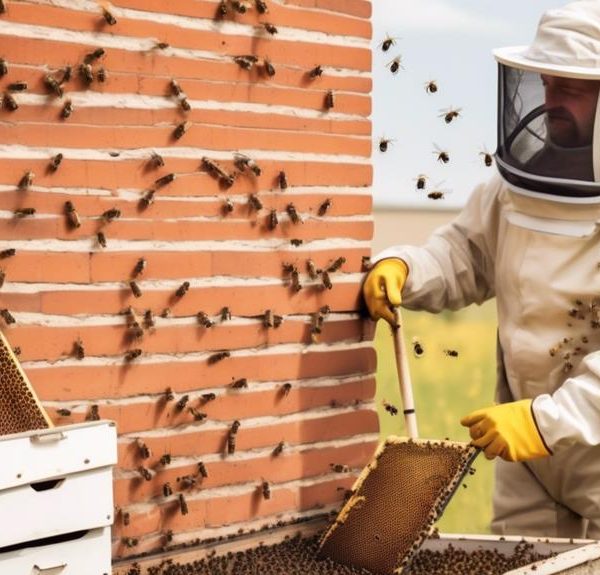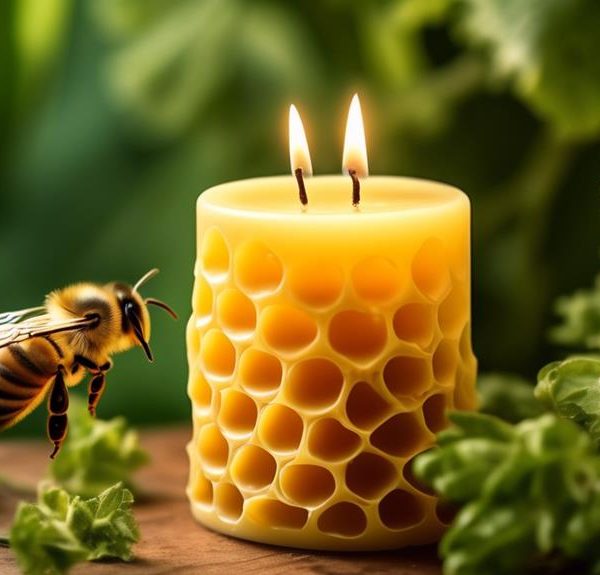Gain insights into the enigmatic world of bee reproduction, a once-in-a-lifetime event yet crucial for the survival of the hive.
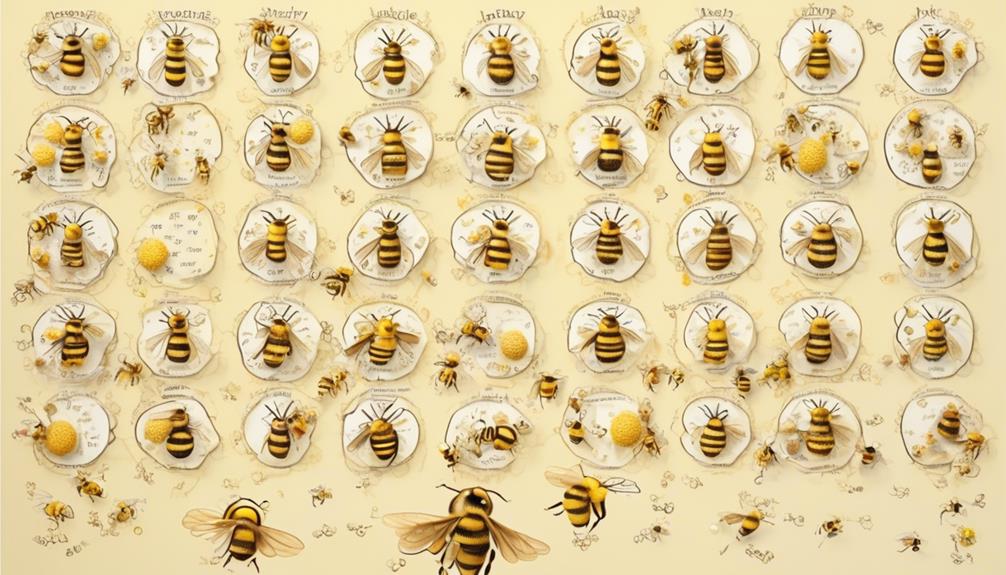
How Often Do Bees Reproduce?
Diving into the world of bees is like stepping into a well-oiled factory, where each worker has a crucial role to play. As you explore their complex ecosystem, you'll find that the reproduction cycle of these fascinating creatures is a critical part of their survival.
Bees, specifically the queen bee, do not mate frequently; in fact, it's a once in a lifetime event for her. Yet, she can lay up to 2000 eggs a day. How is this possible? If bees don't mate frequently, where do all these eggs come from?
We'll unravel these mysteries, and you may be surprised at the intricate processes behind the reproduction of bees.
Key Takeaways
- Queen bees have the primary role of laying eggs, producing up to 2,000 eggs per day during peak season.
- Drones are responsible for mating with the queen and congregate in specific areas known as 'drone congregation areas' (DCAs) to compete for mating.
- The queen mates with multiple drones during her mating flights and stores their sperm to fertilize future eggs.
- Worker bees cannot mate or lay fertilized eggs, but they contribute to the colony's genetic diversity by selecting potential queens and allowing them to mate with drones from other colonies.
Understanding Bee Reproduction
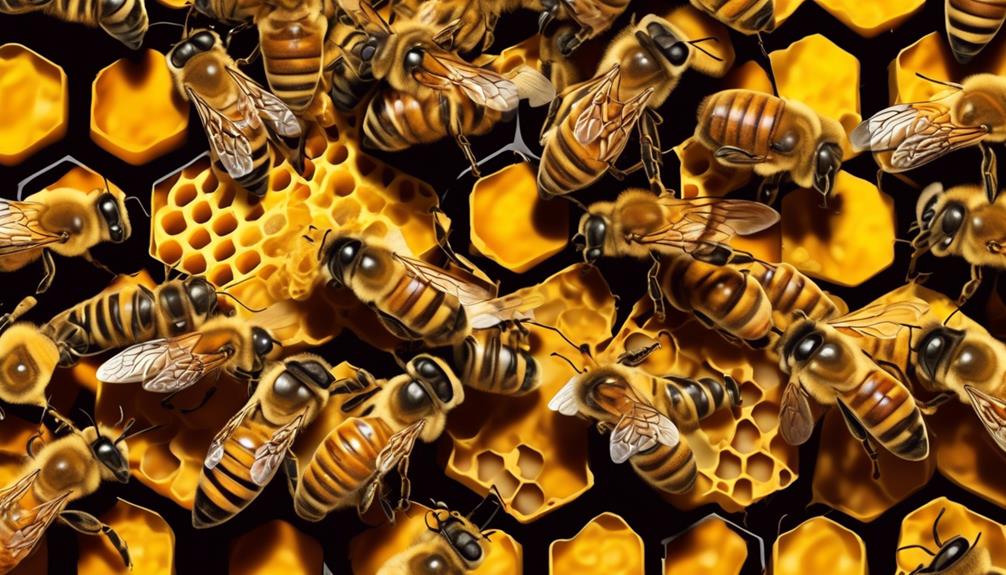
In order to fully comprehend bee reproduction, it's essential to delve into the unique roles and interactions of the queen bees, drones, and worker bees within the hive. You see, in this buzzing society, each bee has a distinct job.
The queen's task? To lay eggs. She's the mother to all bees within the hive, and her primary role is reproduction.
The drones, on the other hand, are the males of the colony. Their sole purpose is to mate with the queen. After a successful mating flight, the drone dies, having fulfilled his role. You should know, this is a one-time deal for these guys.
Then, there are the worker bees. They're the female bees that don't reproduce. Instead, they handle almost everything else in the hive, from foraging for food to caring for the queen and her offspring.
Mating Patterns of Bees
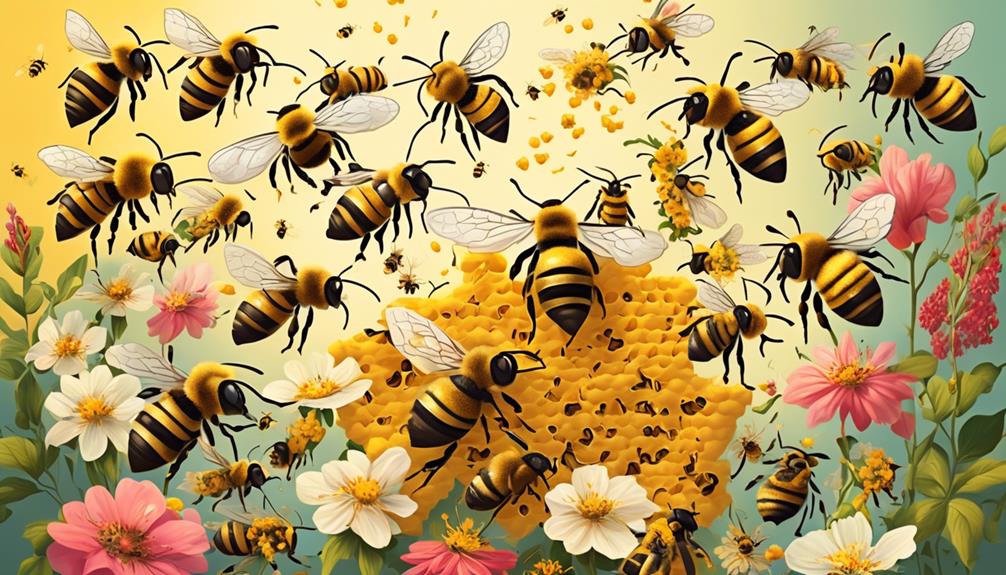
Delving into the world of bee mating patterns, you'll find that these intricate rituals are both fascinating and integral to the survival of the hive. Drones, the male bees, have one sole purpose: to mate with a virgin queen. They're born from unfertilized eggs and represent a small fraction of the hive.
The mating process itself is awe-inspiring. On warm, windless afternoons, drones congregate in specific areas known as 'drone congregation areas' (DCAs). These DCAs are the stage for an intense aerial competition as drones compete to mate with a queen.
The queen, in her short life, will make only one or two mating flights. During these flights, she'll mate with multiple drones, storing their sperm to fertilize future eggs. The queen's ability to control the release of stored sperm allows her to lay both fertilized and unfertilized eggs, controlling the hive's population dynamics.
However, the act of mating is fatal for the drone. After mating, the drone's reproductive organ and a part of its abdomen are torn away, leading to its death. This sacrifice underscores the drone's role in ensuring the survival and continuation of the hive.
The Queen Bee's Role
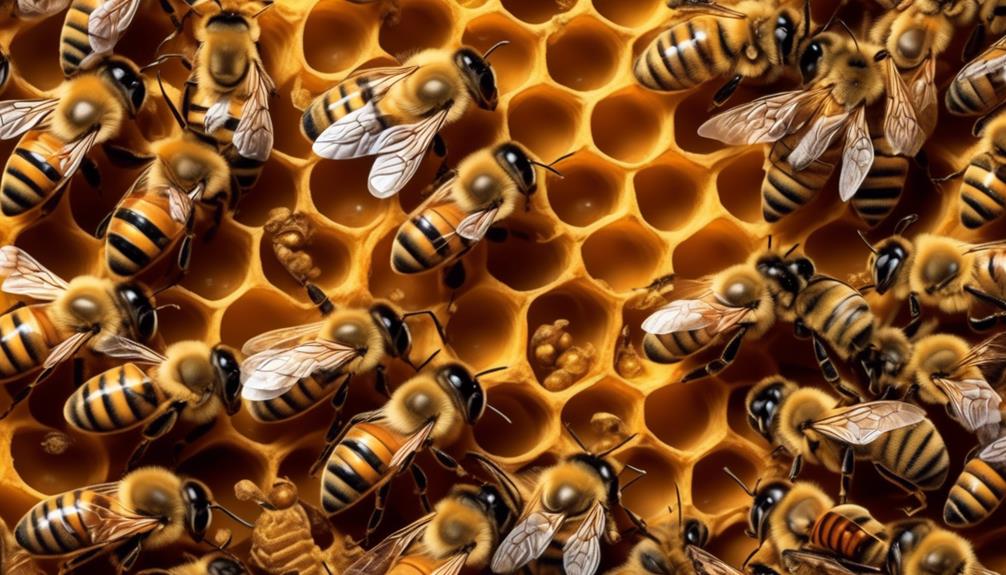
Having explored the drone's sacrificial role in mating, let's now turn our attention to the queen bee, whose duty extends far beyond the brief act of mating. A hive's queen bee is its only reproductive female, laying up to 2,000 eggs per day during peak season. Her fertility is stunning, but it's not her only responsibility.
A queen bee's pheromones are essential for hive harmony. They suppress the worker bees' reproductive systems and promote cooperation within the colony. However, her pheromone production slows as she ages, leading to a potential power struggle. The workers may decide to replace her, a process known as 'supersedure', where a new queen is raised to take over.
You might wonder how a queen bee becomes a queen in the first place. She starts as a regular larva, but she's fed a diet of royal jelly, a substance produced by the worker bees. This diet facilitates her transformation into a queen, equipping her with the vital ability to reproduce.
Worker Bees and Reproduction
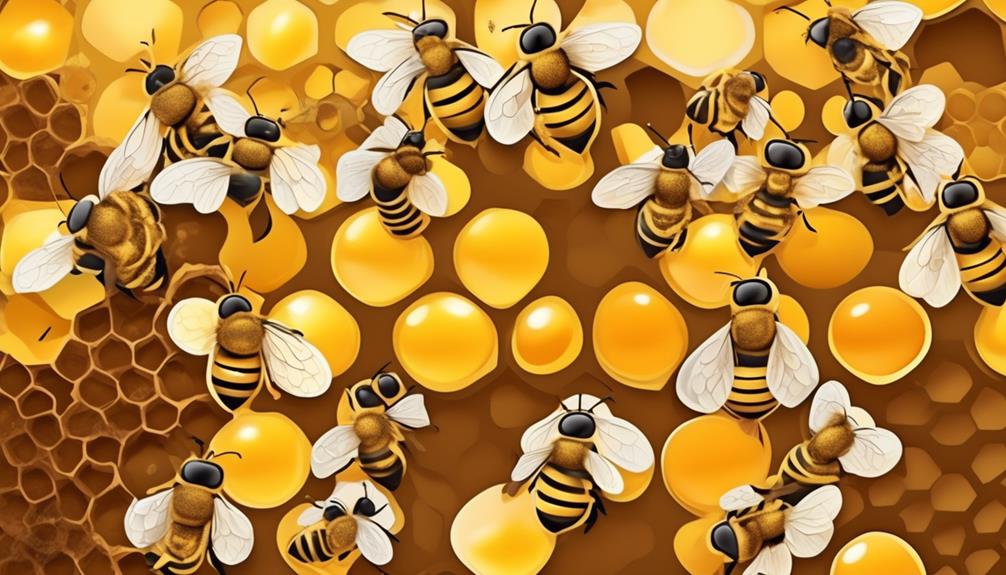
While the queen bee is the sole reproductive female in a hive, worker bees also play a significant role in the colony's reproduction process, despite their own infertility. These industrious females are essentially the backbone of the hive, carrying out tasks that ensure the colony's survival and continuity.
Worker bees, you'll find, are unable to mate or lay fertilized eggs. However, they contribute to reproduction in an indirect way. They're responsible for feeding and taking care of the brood – the colony's eggs, larvae, and pupae. They provide royal jelly, a protein-rich substance, to the queen and young larvae, which is crucial for their development and the queen's egg-laying ability.
They also play a vital role in maintaining the colony's genetic diversity. When a new queen is needed, they select a few larvae and feed them copious amounts of royal jelly, creating potential queens. The surviving individual will then mate with multiple drones from other colonies, ensuring genetic variation within the hive.
Drones: The Male Bees
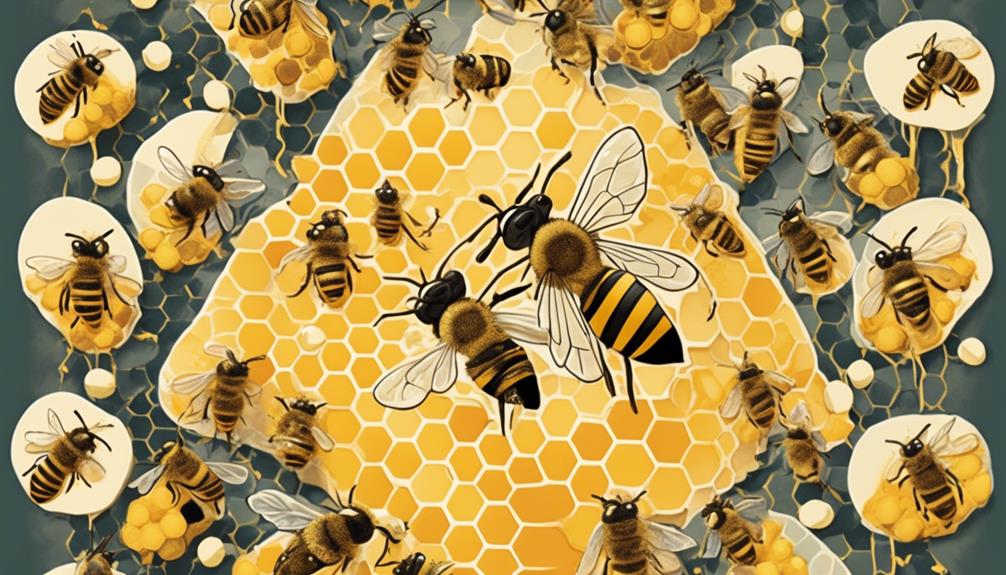
In contrast to the non-reproductive worker bees, let's now explore drones, the sole male members of the bee colony, playing a vital role in the reproductive cycle. Unlike the female worker bees, drones don't gather nectar or pollen. Instead, their primary function is to fertilize the queen.
Drones are larger than worker bees and lack the sting apparatus. They're easily recognizable by their rounded bodies and larger eyes used to spot queens during mating flights. Interestingly, drones don't contribute to the hive's maintenance or defense, leading to their eventual eviction once the mating season ends.
Now, let's delve into their reproductive role. You might wonder, how often do they mate? The answer is once. After mating, drones die because their endophallus, used for mating, breaks off inside the queen, causing their death. It's a tragic but necessary part of the bee's life cycle.
Frequently Asked Questions
What Are the Common Threats to Bee Reproduction?
You're asking about the common threats to bee reproduction.
Pesticides are a major concern, as they can harm the queen's ability to reproduce.
Climate change also impacts bees by disrupting their natural habitats and food sources, which can lead to colony collapse.
Additionally, invasive species and parasites, such as the Varroa mite, can wreak havoc on bee populations.
Lastly, monoculture farming reduces biodiversity and limits the variety of pollen available, hindering bee reproduction.
How Does Climate Change Affect the Reproduction Cycle of Bees?
Climate change can severely disrupt the reproduction cycle of bees. As seasons shift unpredictably, bees are thrown off their mating schedule. Flowers they rely on for sustenance may not bloom when they're active, causing a food shortage.
The increased temperatures also lead to higher mortality rates. You'll find that severe weather events, another consequence of climate change, can destroy bee habitats, making reproduction even more challenging.
Are There Specific Seasons When Bees Reproduce More?
Yes, there are specific seasons when bees reproduce more. It's during spring and summer when flowers are blooming and food is abundant.
Bees, particularly queen bees, increase their reproduction rate to take advantage of this period. As you might guess, a hive's population soars during these seasons.
However, reproduction slows down in fall and winter when food sources become scarce. Remember, a bee's reproduction cycle is heavily influenced by the availability of food and weather conditions.
How Does the Diet of Bees Influence Their Reproduction?
Bees' diet significantly impacts their reproduction. When you're feeding them a diet rich in pollen and nectar, they're more likely to reproduce.
Pollen provides the proteins needed for egg production. Nectar, on the other hand, gives them the energy for mating and egg laying.
Are There Any Significant Differences in the Reproduction Processes of Different Species of Bees?
Yes, there are significant differences in the reproduction processes of different bee species.
Some species, like honeybees, have a queen that mates once and stores the sperm. She'll lay eggs throughout her life.
Other species, like bumblebees, have queens that mate and lay eggs each season.
Solitary bees mate, then the female lays eggs and provides for them alone.
You'll find fascinating variety in bee reproduction methods!
Conclusion
You've delved into the fascinating world of bee reproduction, understanding their distinct mating patterns, the queen bee's pivotal role, and the unique functions of worker bees and drones.
It's clear that bee reproduction isn't a simple process but a complex choreography of nature, integral for the survival of the hive.
Remember, the frequency of reproduction depends on numerous factors, including the health and age of the queen, the hive's needs, and environmental conditions.

